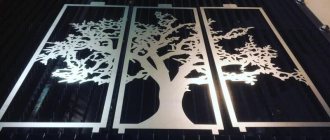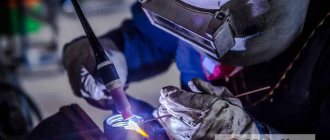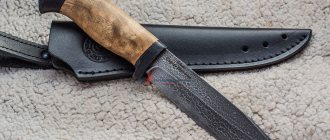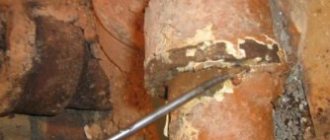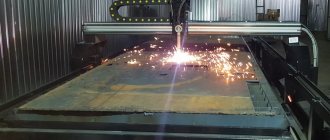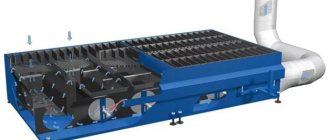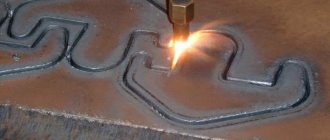02/18/2021 Author: VT-METALL
Issues discussed in the material:
- Laser and plasma cutting of metal: differences and similarities
- Advantages of plasma and laser cutting
- Cost of equipment and consumables for both types of cutting
- The quality of the result after plasma and laser cutting
When choosing which is better – laser and plasma cutting of metal, you must first take into account the differences and similarities of the two types. This is important both for selecting equipment for your own production and for ordering cutting on the outside. Understanding the strengths and weaknesses of each method will allow you to get quality products and stay within your budget.
Despite the fact that one can come across an opinion about the superiority of laser over plasma, it would be more correct to say that everything depends on the thickness and type of metal being cut. In one case you need to choose a laser, in another case plasma is suitable. In our article we will talk about all the features of these technologies and determine in what conditions and what is best to use.
How is laser cutting different from plasma cutting?
Let's first look at the operating principle of plasma and laser equipment.
In simple words, metal melting during plasma cutting occurs due to the arc. That is, under the influence of air.
In the case of laser cutting, plasma cutting melts the metal due to a focused laser beam.
Installation cost
Often the final decision on whether to equip a production facility with a laser or plasma is influenced by the cost of installation and operating costs.
To correctly understand the issue of the cost of laser and plasma installations, we will assume that it is assumed that metal of the same thickness will be cut at the same speed. At the same time, at thicknesses up to 4..6 mm, a laser system is approximately 4..6 times more expensive than a plasma one; with a thickness of 6..20 mm, the difference in price is already 10 times or more.
When cutting metal with a thickness of more than 20 mm, the use of laser cutting becomes available only to large industries with unique specific tasks.
The coordinate system for a laser installation is subject to increased requirements for dynamic and accuracy characteristics; accordingly, it is necessary to use components of higher accuracy. As a result, the cost of a laser coordinate system is 3..4 times higher.
Plasma and laser cutting capabilities
In the first case, the width of the cut is not constant. It varies depending on the thickness of the metal, from 0.8 to 2.5 mm. And when working on a laser machine, it is always almost the same and equals from 0.2 to 0.3 mm.
How accurate plasma cutting will be depends on the wear and tear of the consumables. This parameter is up to 0.1 mm. With the laser method, the accuracy is very high and ranges from 0.05 to 0.08 mm.
An important parameter is the taper; it ranges from 1 to 5 degrees depending on the thickness of the holes being cut. With laser, the taper is minimal. It is less than 1 degree.
Accordingly, the laser holes are more geometrically correct and suitable for precise connections.
In order to cut geometrically correct holes on the plasma, we need the diameter of the hole to be twice as thick as the sheet.
And with laser cutting, it is possible to cut holes at least twice as thin as the sheet itself.
It is also necessary to note the high cutting speed, which makes it possible to burn through thick metals.
And the speed with a laser is much higher than with plasma. But as the thickness increases, it drops significantly. In addition, the time required to pierce thick metal increases.
It is worth noting about the formation of scale during plasma cutting. Unfortunately, it is impossible to avoid it, and the part will still need to be processed.
But with laser cutting it is practically absent. That is, parts that are cut out by laser do not require additional processing.
Plasma has a dirty cut, that is, when cutting plasma, a lot of burr is formed, and the cut needs post-processing. That is, in any case, you need to either grind, or galvanize, or clean the material in other ways.
In the case of a laser machine, with the correct settings, it does not require any post-processing. The product is immediately ready for welding, painting, and later for sale. The cut comes out clean.
The laser has a very thin cut, and with plasma it can reach 5 mm due to the fact that the temperature effect is high, which gives additional melting.
A metal laser machine consumes much less electricity than plasma. This is especially noticeable at large volumes.
Cost of equipment and consumables for both types of cutting
When choosing a plasma or laser method for cutting metal, you must take into account that the price of a portal plasma installation is 5-6 times less than a similar laser one. However, when comparing both methods, you should calculate not only the initial price, but also the costs of further maintenance.
This includes the cost of electricity, the use of auxiliary gases and the cost of consumables. When deciding on the choice of plasma or laser cutting, it is necessary to take into account that the estimated cost of operating a laser cutting machine includes:
- Gas prices:
- pure oxygen or air - for treating steels with a high carbon content;
- nitrogen – when using workpieces made of aluminum (or its alloys) and corrosion-resistant (stainless) steels and alloys.
- Energy consumption costs:
- energy consumption costs of the installation itself;
- the cost of electricity spent on the laser and cooler.
- Consumables, which include:
- internal and external optics;
- replacing worn nozzles;
- cleaning and replacing filters.
The intensity of operation of laser systems has a significant impact on the frequency of replacement of consumables: from once every several weeks or years.
Without information on the operating costs of a plasma processing installation, it would be difficult to answer the question of how plasma cutting differs from laser cutting. For this reason, we continue to study in more detail the costs of alternative types of equipment.
Plasma cutting uses air or oxygen. Electricity is spent only on creating plasma and powering the machine itself. If we talk about consumables, then you need the same amount of them as when using a laser. These include:
- protective screen;
- electrode;
- nozzle.
Reducing the cost of a plasma cutter can be achieved by using low-current nozzles and electrodes, but this will lead to a decrease in machine productivity, but will not affect the quality of the cut.
Considering the question of how many holes should be per workpiece in order to reduce the hourly cost of work, we can safely say that the advantage is on the side of the laser, since the electrodes and nozzles used in plasma installations are designed for a given number of starts and flashes.
The more holes that need to be made, the higher the operating costs of plasma equipment.
What consumables are needed?
For plasma cutting machine
On plasma it is necessary to change nozzles, electrodes, protective screens, and casings. And on the laser there are only lenses and a nozzle.
For laser machine
But when working on a laser machine, it is necessary to change the lens and nozzle every two weeks. The lens costs 700 rubles, the nozzle costs 900 rubles.
The maximum monthly payment for consumables for a laser machine will be 3,200 rubles.
So let's summarize.
Easy to operate laser cutter
Laser is more profitable than plasma also because of the ease of operation of cutting equipment. The difficulties in using a plasma machine are due to the complexity of its design. A cutter based on an ionized gas environment includes the following elements:
- plasma nozzles;
- cooling system (air or water);
- gas supply device;
- electric arc exciter.
The nozzles that generate the plasma beam are exposed to high temperatures of approximately 5000 °C and need to be replaced periodically. In addition, other components require regular maintenance.
The laser machine is much simpler, which makes it easier to operate. It does not contain nozzles or coolers. The light beam is formed using optics on which photons do not have a temperature effect, so the photon beam former does not need to be cooled. To cut metal with a laser, no electric arc is required.
Pros and cons of plasma and laser
Plasma
Advantages:
- Wide range of cut thicknesses from 0.5 to 50 mm per punch ;
- High cutting speed at large thicknesses;
- Low initial price of equipment
- Well-proven technology for cutting at an angle, as they are now used to calling it, cutting with a bevel.
Flaws:
- It is inappropriate to process metals thinner than 1 mm;
- Edge taper up to 5 degrees (poor quality edge);
- The presence of scale on the holes when turning, so additional processing of the products is required;
- Restriction on hole diameter up to 4 mm;
- High cost of consumables;
- Low accuracy compared to a laser machine;
- Requires post-processing;
- Low cutting speed compared to laser on thin materials;
- Inability to perform many types of cutting available to a laser machine.
Laser
Advantages:
- Edge perpendicularity;
- Small cutting width;
- No scale - you get a 100% finished product;
- The diameter of the hole is less than the thickness of the sheet. You can cut out small parts down to 1 mm;
- Low thermal impact on the edge;
- Cheap consumables;
- Processing of thin metal from 0.2 mm;
- Highest possible cutting speed;
- The materials require no post-processing and are ready to be welded, painted or packaged and then sold.
Flaws:
- You can cut metal only up to 20 mm;
- High initial price of equipment.
Thickness and type of metal being cut
In principle, both technologies allow cutting any metals. These include all types of steel, non-ferrous and ferrous metals. When using a laser, optimization of parameters, selection of lenses and gas for a specific metal is required. Let’s say that in an oxygen environment, stainless steel cannot be cut efficiently with a laser; you need an inert gas. On the contrary, for ferrous metals, oxygen is better. Plasma generally cuts any conductive materials. It all depends on the composition of the plasma-forming gas and the gap between the metal surface and the nozzle.
Laser
Effective when processing metal up to 5 – 6 mm thick. Cutting thin sheet metal is carried out at a much higher speed than a plasma torch can in principle. When processing thicker materials, energy consumption increases, productivity and cut quality decrease. The power has to be doubled or more, and a lens with a longer focal length must be installed.
Plasma cutter
It is not suitable for processing thin sheet metals due to the excessively high plasma temperature and edge deformation. The advantages begin to be felt when cutting metal with a thickness of 6 mm and above, if we are talking about steel.
What is plasma used for and what is laser used for?
The laser is suitable where accuracy, cleanliness of cuts and edges and speed are needed. And plasma cuts slowly, relative to a laser, and with a dirty cut, so it is impossible to cut out complex technical parts. And on a metal laser machine it is possible to cut, for example, small nameplates and plates, thin grilles and complex design elements, as well as rotary wheels.
Plasma is needed to make simple products. In the shape of a rectangle, oval or square, because they can be processed later. But cutting out a star with holes inside will be difficult. Plus, sanding will take a lot of time. And post-processing equipment will cost several times more than a metal cutter.
Plasma is used where there are large thicknesses and for simple cutting, for example, rails, metal frame elements or welded structures, etc.
Payback of machines
The return period for the invested money is approximately the same for both machines, despite the fivefold difference in cost. The fact is that due to higher cutting accuracy and edge quality, laser cutting is significantly more profitable and the profit margin is higher. Added to this are performance benefits, greater functionality, and lower maintenance costs. When the equipment pays for itself, the laser machine will begin to generate large profits, and significantly, especially if its potential is fully realized.
To summarize, we can say that when processing thin metal, the need for precise cutting, all the advantages are on the side of laser cutting, with the exception of the cost of the machine. When working with materials with a thickness of about 6 mm, the technologies are comparable in efficiency. Metals with a thickness of 10, 20 mm and higher are best processed with a plasma torch.
has been supplying equipment for laser cutting of materials for more than ten years. You can get complete information about the range of equipment, prices, delivery conditions on the company’s website or by phone.
Application area
Plasma cutting is used in heavy engineering enterprises, nuclear power engineering, aviation industry, in the construction industry, in public utilities, and in outdoor advertising (for the production of metal signs). It is used for cutting pipes, sheet metal, cast iron, steel, concrete, as well as for shaped cutting of metal and bolt holes. Laser cutting has a wide range of applications and affects: medicine, mechanical engineering, instrument making, etc.
Laser cutting of metal


